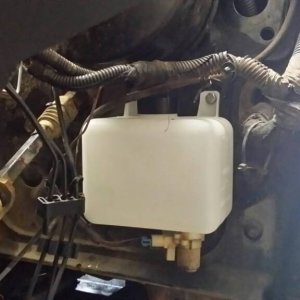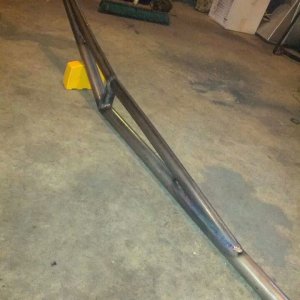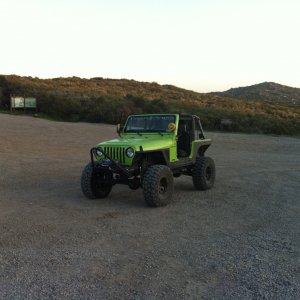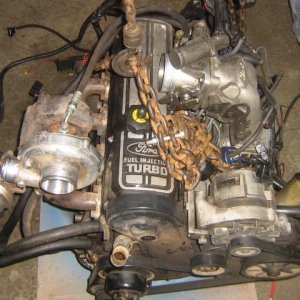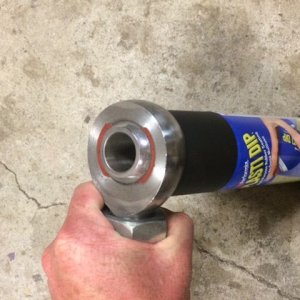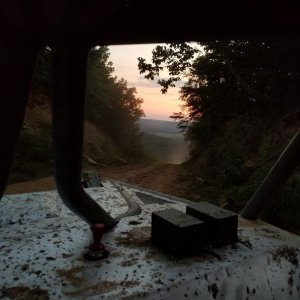patooyee
Well-Known Member
- Joined
- Sep 27, 2008
- Messages
- 5,692
I have heard both sides of the brake line size theory. I have heard that line size doesn't matter so long as the instantaneous fluid movement is not restricted. There is no appreciable fluid movement within the lines, it is primarily pressure transmission, which takes place instantaneously and equally at all points in the system, thus no advantage of a larger line. Here is a snip from Billavista's brake bible:
"Note that ¼" DOES NOT "provide more volume" to actuate the callipers more quickly as I have read more times than I care to remember. The MC piston's bore and stroke determines the fluid volume displaced and therefore the pedal stroke required to apply the brakes. The tubing is sealed and full – its diameter has nothing to do with it (within reason) and you certainly won't notice the difference between ¼" and 3/16" – except maybe the placebo effect coz your buddy said so!"
There are multiple other sources you can find via Google that say the same. Multiple that say the opposite.
On my last buggy I had 1/4" lines because people told me it was better. At some point I ended up switching to 3/16 lines, I forget why. It had something to do with 1/4" fittings not being available for a modification I was doing. (This was with pinion brakes, so it was less of a hassle than wheel brakes.) I noticed no difference in braking.
For my new buggy I consulted some specialty brake company, I forget who. The name started with a B, it was the last name of two brothers who owned the company. This company was recommended to me by mr blaine on Pirate, who is a very opinionated, yet knowledgeable, brake guy. It came as no surprise when I called them that they were also very opinionated. But they were vehement about line size not mattering. In fact, he said that 1/4" / -4an could be a hindrance since it has greater propensity to swell under pressure and therefore waste energy.
I'm not saying that I believe one or the other school of thought, just putting it out there for consideration. My current buggy has HB with -3AN lines and huge, beefy 1-ton calipers and 13" vented rotors. It stops on an absolute dime with almost no effort, I love it. It does weigh probably 3x what anything with Wilwood calipers weighs though. I appreciate crawlin's willingness to discuss this topic and hope that I didn't put him on the spot too bad by asking.
The pics of that booster setup look to be about the same as my Chevy 1-ton setup, not anything more compact. Maybe its just an illusion of photography. I've seen lots of HB setups and they are all pretty much identical in dimension, all the way from passenger cars to medium-duty trucks like Kodiacs, doesn't matter Ford, Chevy, or Dodge. The HB unit on my '05 Dodge tow rig looks identical to the one off of a '78 Chevy CUCV that is in my buggy as well as another I have seen out of a Lincoln Towncar, my old '04 Ford F-250, and my Dad's '12 Dodge 3500. If you look at HB parts suppliers you will find that the rebuild kits are universal. One kit for all applications. I'm sure there are slight variations among them but it leads me to think that whatever HB unit the American manufacturers are using is pretty much universal. (I have no experience with foreign makers.) Also, WOD's web site does not mention their HB kit being any smaller than any others.
http://www.wideopendesign.com/Product/10872/Hydroboost-Brake-Assembly.aspx
Their booster appears to be identical to my '78 CUCV booster. The main advantage I see to their kit is the brake pedal and bracket it comes with. I fabbed those on my own for my current buggy. They are kind of a PITA to work with because of the way the booster attaches to the firewall with a huge 8-sided nut and a key. Many people I know simply get the OEM bracket and weld it into their firewall.
"Note that ¼" DOES NOT "provide more volume" to actuate the callipers more quickly as I have read more times than I care to remember. The MC piston's bore and stroke determines the fluid volume displaced and therefore the pedal stroke required to apply the brakes. The tubing is sealed and full – its diameter has nothing to do with it (within reason) and you certainly won't notice the difference between ¼" and 3/16" – except maybe the placebo effect coz your buddy said so!"
There are multiple other sources you can find via Google that say the same. Multiple that say the opposite.
On my last buggy I had 1/4" lines because people told me it was better. At some point I ended up switching to 3/16 lines, I forget why. It had something to do with 1/4" fittings not being available for a modification I was doing. (This was with pinion brakes, so it was less of a hassle than wheel brakes.) I noticed no difference in braking.
For my new buggy I consulted some specialty brake company, I forget who. The name started with a B, it was the last name of two brothers who owned the company. This company was recommended to me by mr blaine on Pirate, who is a very opinionated, yet knowledgeable, brake guy. It came as no surprise when I called them that they were also very opinionated. But they were vehement about line size not mattering. In fact, he said that 1/4" / -4an could be a hindrance since it has greater propensity to swell under pressure and therefore waste energy.
I'm not saying that I believe one or the other school of thought, just putting it out there for consideration. My current buggy has HB with -3AN lines and huge, beefy 1-ton calipers and 13" vented rotors. It stops on an absolute dime with almost no effort, I love it. It does weigh probably 3x what anything with Wilwood calipers weighs though. I appreciate crawlin's willingness to discuss this topic and hope that I didn't put him on the spot too bad by asking.
The pics of that booster setup look to be about the same as my Chevy 1-ton setup, not anything more compact. Maybe its just an illusion of photography. I've seen lots of HB setups and they are all pretty much identical in dimension, all the way from passenger cars to medium-duty trucks like Kodiacs, doesn't matter Ford, Chevy, or Dodge. The HB unit on my '05 Dodge tow rig looks identical to the one off of a '78 Chevy CUCV that is in my buggy as well as another I have seen out of a Lincoln Towncar, my old '04 Ford F-250, and my Dad's '12 Dodge 3500. If you look at HB parts suppliers you will find that the rebuild kits are universal. One kit for all applications. I'm sure there are slight variations among them but it leads me to think that whatever HB unit the American manufacturers are using is pretty much universal. (I have no experience with foreign makers.) Also, WOD's web site does not mention their HB kit being any smaller than any others.
http://www.wideopendesign.com/Product/10872/Hydroboost-Brake-Assembly.aspx
Their booster appears to be identical to my '78 CUCV booster. The main advantage I see to their kit is the brake pedal and bracket it comes with. I fabbed those on my own for my current buggy. They are kind of a PITA to work with because of the way the booster attaches to the firewall with a huge 8-sided nut and a key. Many people I know simply get the OEM bracket and weld it into their firewall.


![IMG_9807[1].JPG](http://attachments.www.hardlinecrawlers.com/xfmg/thumbnail/13/13655-c73abaf668f3355962dda2dd4b6883f0.jpg?1625929949)
